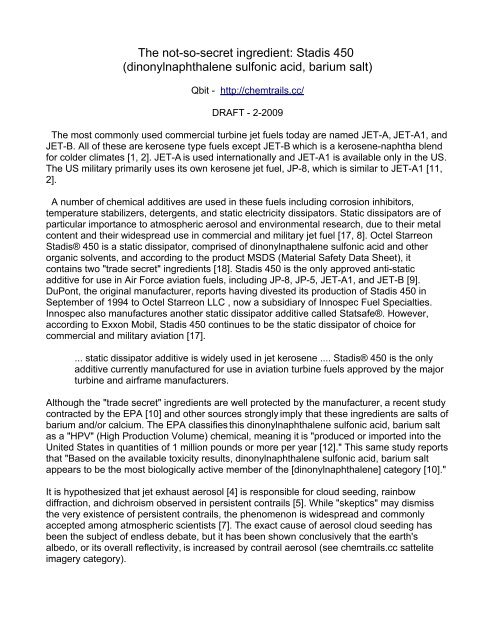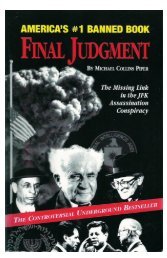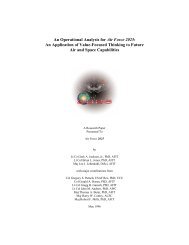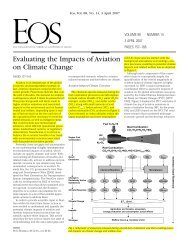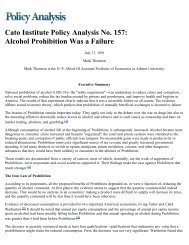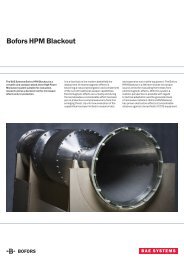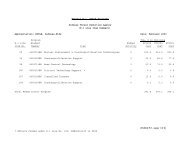The not-so-secret ingredient: Stadis 450 (dinonylnaphthalene ...
The not-so-secret ingredient: Stadis 450 (dinonylnaphthalene ...
The not-so-secret ingredient: Stadis 450 (dinonylnaphthalene ...
Create successful ePaper yourself
Turn your PDF publications into a flip-book with our unique Google optimized e-Paper software.
<strong>The</strong> <strong>not</strong>-<strong>so</strong>-<strong>secret</strong> <strong>ingredient</strong>: <strong>Stadis</strong> <strong>450</strong><br />
(<strong>dinonylnaphthalene</strong> sulfonic acid, barium salt)<br />
Qbit - http://chemtrails.cc/<br />
DRAFT - 2-2009<br />
<strong>The</strong> most commonly used commercial turbine jet fuels today are named JET-A, JET-A1, and<br />
JET-B. All of these are kerosene type fuels except JET-B which is a kerosene-naphtha blend<br />
for colder climates [1, 2]. JET-A is used internationally and JET-A1 is available only in the US.<br />
<strong>The</strong> US military primarily uses its own kerosene jet fuel, JP-8, which is similar to JET-A1 [11,<br />
2].<br />
A number of chemical additives are used in these fuels including corrosion inhibitors,<br />
temperature stabilizers, detergents, and static electricity dissipators. Static dissipators are of<br />
particular importance to atmospheric aero<strong>so</strong>l and environmental research, due to their metal<br />
content and their widespread use in commercial and military jet fuel [17, 8]. Octel Starreon<br />
<strong>Stadis</strong>® <strong>450</strong> is a static dissipator, comprised of dinonylnapthalene sulfonic acid and other<br />
organic <strong>so</strong>lvents, and according to the product MSDS (Material Safety Data Sheet), it<br />
contains two "trade <strong>secret</strong>" <strong>ingredient</strong>s [18]. <strong>Stadis</strong> <strong>450</strong> is the only approved anti-static<br />
additive for use in Air Force aviation fuels, including JP-8, JP-5, JET-A1, and JET-B [9].<br />
DuPont, the original manufacturer, reports having divested its production of <strong>Stadis</strong> <strong>450</strong> in<br />
September of 1994 to Octel Starreon LLC , now a subsidiary of Innospec Fuel Specialties.<br />
Innospec al<strong>so</strong> manufactures a<strong>not</strong>her static dissipator additive called Statsafe®. However,<br />
according to Exxon Mobil, <strong>Stadis</strong> <strong>450</strong> continues to be the static dissipator of choice for<br />
commercial and military aviation [17].<br />
... static dissipator additive is widely used in jet kerosene .... <strong>Stadis</strong>® <strong>450</strong> is the only<br />
additive currently manufactured for use in aviation turbine fuels approved by the major<br />
turbine and airframe manufacturers.<br />
Although the "trade <strong>secret</strong>" <strong>ingredient</strong>s are well protected by the manufacturer, a recent study<br />
contracted by the EPA [10] and other <strong>so</strong>urces strongly imply that these <strong>ingredient</strong>s are salts of<br />
barium and/or calcium. <strong>The</strong> EPA classifies this <strong>dinonylnaphthalene</strong> sulfonic acid, barium salt<br />
as a "HPV" (High Production Volume) chemical, meaning it is "produced or imported into the<br />
United States in quantities of 1 million pounds or more per year [12]." This same study reports<br />
that "Based on the available toxicity results, <strong>dinonylnaphthalene</strong> sulfonic acid, barium salt<br />
appears to be the most biologically active member of the [<strong>dinonylnaphthalene</strong>] category [10]."<br />
It is hypothesized that jet exhaust aero<strong>so</strong>l [4] is responsible for cloud seeding, rainbow<br />
diffraction, and dichroism observed in persistent contrails [5]. While "skeptics" may dismiss<br />
the very existence of persistent contrails, the phenomenon is widespread and commonly<br />
accepted among atmospheric scientists [7]. <strong>The</strong> exact cause of aero<strong>so</strong>l cloud seeding has<br />
been the subject of endless debate, but it has been shown conclusively that the earth's<br />
albedo, or its overall reflectivity, is increased by contrail aero<strong>so</strong>l (see chemtrails.cc sattelite<br />
imagery category).
In the 3 days after the attacks on Sept. 11, 2001 during which the FAA grounded all<br />
commercial aircraft in the US, a unique opportunity to study atmospheric aero<strong>so</strong>l presented<br />
itself. David J. Travis, University of Wisconsin found significant changes in surface<br />
temperature and presented his findings to the American Meteorological Society [6].<br />
<strong>The</strong>re are a number of byproducts of combustion of kerosene jet fuel and its additives,<br />
including water, carbon dioxide, <strong>so</strong>ot, sulfuric and nitrous acid, sulfur and nitrogen oxides, and<br />
metal ions [3], although this is by no means a complete list. Carbon monoxide and aromatic<br />
hydrocarbons al<strong>so</strong> result from incomplete combustion.<br />
Aero<strong>so</strong>l and contrail formation processes in an aircraft plume and wake as a function of plume age and<br />
temperature [4]. (image courtesy GRID-Arendal)<br />
Not surprisingly, UNEP (United Nations Environment Programme) only makes casual mention<br />
of these metal particles, and fails to provide any information as to their role in atmospheric<br />
aero<strong>so</strong>l formation.<br />
If one phenomenon gives away the presence of metals in the aero<strong>so</strong>l, it would be the large<br />
number of high altitude rainbows produced by contrail aero<strong>so</strong>l. Virtually unheard of prior to<br />
1990, bright rainbows, <strong>so</strong>metimes referred to as "circumhorizon arcs" or more commonly,<br />
"chembows," can be observed regularly wherever jet aircraft fly.<br />
According to a patent issued to Hughes Aircraft Company for dispersing metallic aero<strong>so</strong>l into<br />
the stratosphere, particles may stay suspended for up to a year. Hughes Aircraft, a major US<br />
defense contractor [14, 15], has been bought and <strong>so</strong>ld by other defense contractors such as<br />
Boeing and Raytheon in recent years.<br />
Exeprt from United States Patent 5003186:<br />
<strong>The</strong> particles may be seeded by dispersal from seeding aircraft; one exemplary<br />
technique may be via the jet fuel as suggested by prior work regarding the metallic<br />
particles. Once the tiny particles have been dispersed into the atmosphere, the<br />
particles may remain in suspension for up to one year.
To avoid making qualitative judgments, I will <strong>not</strong> belabor the point that the horizon has been<br />
consistently gray, anywhere near commercial airports, since at least the early 1990s. But it<br />
would appear that the metal aero<strong>so</strong>l is indeed being dispersed, and staying suspended. While<br />
corporate media generally claims there can be no further debate about climate change, there<br />
are thousands of respected scientists who dispute the <strong>not</strong>ion that atmospheric CO2 is the<br />
primary cause, and take exception to the idea that human intervention is required to "correct"<br />
it. At least 400 of them have testified to this effect to the US Senate [16].<br />
Critical thinkers must question whether, with such flimsy scientific evidence, controlling the<br />
climate is the true motivation behind this metal aero<strong>so</strong>l dispersal. A 10 mile thick blanket of<br />
metal aero<strong>so</strong>l may have other uses to the militaries of the world, particularly in the fields of<br />
surveillance, aircraft and missile guidance, radar ducting, and radio frequency weapons<br />
systems.<br />
Citations<br />
1. http://www.csgnetwork.com/jetfuel.html<br />
2. http://en.wikipedia.org/wiki/Jet_fuel<br />
3. GRID-Arendal in collaboration with United Nations Environment Programme (UNEP).<br />
http://www.grida.no/publications/other/ipcc_sr/?src=/climate/ipcc/aviation/034.htm<br />
4. http://chemtrails.cc/2009/01/27/arkansas-news-report/<br />
5. http://chemtrails.cc/2009/01/25/what-are-chembows/<br />
6. http://www.wired.com/science/discoveries/news/2002/05/52512<br />
7. http://www.agu.org/sci_<strong>so</strong>c/prrl/prrl9919.html<br />
8. DETAIL SPECIFICATION, TURBINE FUEL, AVIATION, KEROSENE TYPE, JP-8 (NATO<br />
F-34), NATO F-35, and JP-8+100 (NATO F-37) [pdf]. U.S. Army. Downloaded from<br />
http://www.hnd.usace.army.mil/stddgn/data%5C078_24_28%5CPreviews%5C15880.pdf<br />
9. AEF Fuels Management Pocket Guide [pdf]. U.S. Air Force. Downloaded from<br />
http://www.aflma.hq.af.mil/lgj/AEF_fules_book_2007_final.pdf<br />
10. High Production Volume (HPV) Challenge Program Test Plan and Data Review,<br />
Dinonylnaphthalene Category [pdf].<br />
http://www.epa.gov/hpv/pubs/summaries/dinapcat/c15766tp.pdf<br />
11. http://www.globalsecurity.org/military/systems/aircraft/systems/engines-fuel.htm<br />
12. http://www.epa.gov/hpvis/<br />
13. PermitApplicationReports200808-Marathon_<strong>Stadis</strong>_<strong>450</strong>.pdf Source:<br />
http://www.louisvilleky.gov/NR/rdonlyres/E20509AE-4D28-4603-83B3-<br />
B16A640C9D10/0/PermitApplicationReports200808.pdf<br />
14. Hughes Aircraft Company<br />
15. http://en.wikipedia.org/wiki/Hughes_Aircraft<br />
16. Over 400 Prominent Scientists Disputed Man-Made Global Warming Claims in 2007.<br />
From http://epw.senate.gov/public/index.cfm?FuseAction=Minority.SenateReport<br />
17. Exxon Mobil World Jet Fuel Specifications with Avgas Supplement. From:<br />
http://www.exxonmobilaviation.com/AviationGlobal/Files/WorldJetFuelSpec2008_1.pdf<br />
18. Octel Starreon <strong>Stadis</strong> <strong>450</strong> MSDS


